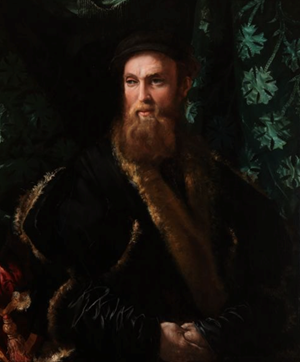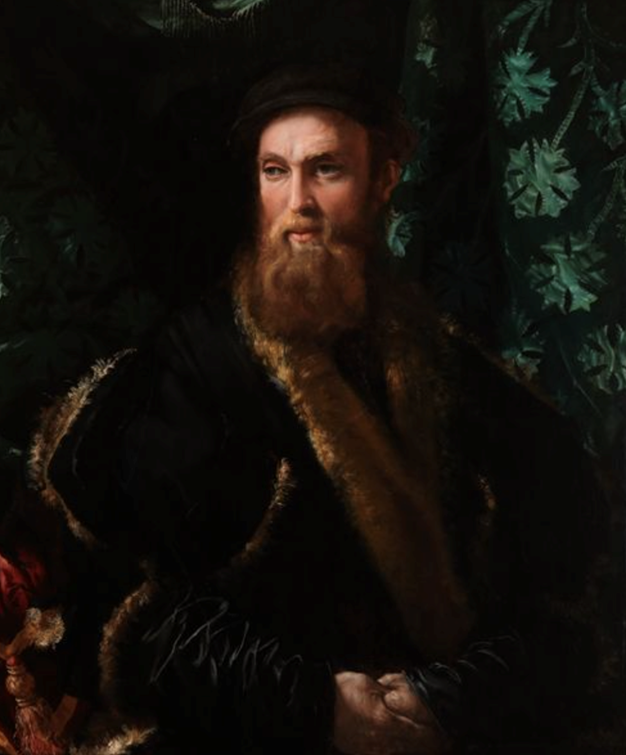
The Metropolitan Museum of Art has received a gift of an exceptional oil painting by celebrated Italian artist Francesco Salviati (1510–1563).
The Metropolitan Museum of Art has received a gift of an exceptional oil painting by celebrated Italian artist Francesco Salviati (1510–1563).
Executed on a one-inch thick marble slab, the arresting portrait depicts Bindo Altoviti (1491–1557), a powerful Florentine banker and one of the most significant political opponents to the Medici rulers. The monumental work is the first painting on marble acquired by The Met. It is a gift from the trust of Assadour "Aso" O. Tavitian.
“The artistic importance and historic magnitude of this painting cannot be overstated,” said Max Hollein, Marina Kellen French Director of The Met. “Salviati’s work is simply extraordinary, both in its material aspect, on marble, and in its painterly execution. The sumptuous portrait brilliantly captures the subject’s immense wealth and social position, while also conveying his bold, cultured, and independent nature. We are endlessly grateful to the late Aso O. Tavitian for this transformative addition to our holdings of European paintings.”
Stephan Wolohojian, John Pope-Hennessy Curator in Charge of the Department of European Paintings, added, “This extraordinary portrait adds immeasurably to The Met’s impressive collection of 16th-century Italian portraits. It is truly an honor and a thrill to add this remarkable painting to that group. Artists in 16th-century Rome often painted on slate. Painting on marble, however, was incredibly rare. I know of no other portrait of this large dimension on marble from the 16th century. Salviati returned to Rome in the early 1540s after an extended stay in Northern Italian artistic centers, such as Venice and Bologna, and the rich color and material opulence of this portrait extends from there. It is easy to imagine Bindo engaging an artist to create his likeness on marble in a non-Florentine manner as a defiant gesture against the Medici.”

Born in Rome, of Florentine parentage, Bindo Altoviti was one of the wealthiest and most influential men of his day. He carried out a politically astute policy of loans to a succession of popes, the Venetian state, and European powers such as King Henry II of France. Leader of the Florentine community in Rome, he maintained a neutral position toward the Medici family until he became a supporter of the Farnese Pope Paul III (r. 1534–49). From the end of the 1540s, Bindo was openly anti-Medicean, and in 1554 he was finally declared a rebel by Cosimo I de’ Medici.
A major patron of the arts, Bindo had his likeness captured at various stages of his life: as a young man around 1512 by Raphael, and several years after Salviati’s portrait, in 1549 in a bronze bust by Benvenuto Cellini. No other sequence of portraits of a sitter, from youth to old age by such an exceptional constellation of artists, survives from the Renaissance.
Francesco de’ Rossi, better known as Francesco Salviati, is among the most iconic painters and draftsmen of the 16th century. He was Florentine by birth, but his career was marked by long periods spent in Rome and northern Italy, primarily Venice and Bologna. His pan-Italian style is evident in his naturalistic portrait of Bindo, created at the height of the banker’s career. Salviati depicts the bearded sitter wearing a cap and fur-lined coat, resting against plush red cushions with gold trim and tassels in front of an opulent green velvet curtain embroidered with satin-silk motifs. The attribution of the portrait was once disputed but is now confidently ascribed to Salviati.
The portrait is on view in The Met’s gallery dedicated to Italian Renaissance sculpture and decorative arts (Gallery 503). Following the completion of the skylights project in November 2023, it will be displayed in the galleries for pre-1800 European paintings. The work was previously loaned to The Met for the 2021 exhibition The Medici: Portraits and Politics, 1512–1570.

ArtDependence Magazine is an international magazine covering all spheres of contemporary art, as well as modern and classical art.
ArtDependence features the latest art news, highlighting interviews with today’s most influential artists, galleries, curators, collectors, fair directors and individuals at the axis of the arts.
The magazine also covers series of articles and reviews on critical art events, new publications and other foremost happenings in the art world.
If you would like to submit events or editorial content to ArtDependence Magazine, please feel free to reach the magazine via the contact page.